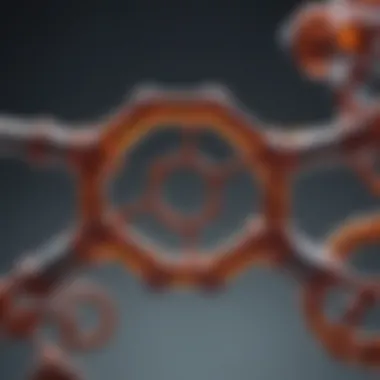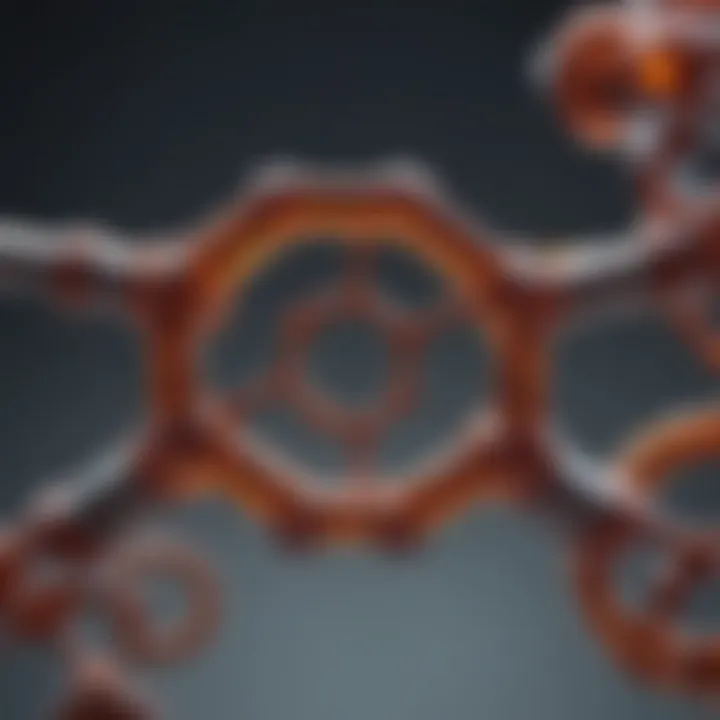Benzene Sulfonic: Key Properties and Applications


Intro
Benzene sulfonic compounds stand at the intersection of chemistry and industrial application. They are intriguing not just for their unique chemical structures but also for the various roles they play in our daily lives. From their noteworthy properties to their multifaceted reactions, these compounds serve as vital players in organic synthesis and numerous industrial processes.
To understand the significance of benzene sulfonics, it's essential to break down the nuances of their properties and applications. With that in mind, the following sections will provide a systematic exploration: starting from the foundational research overview, methodical synthesis techniques, to the broader implications of these compounds in today’s world.
Intro to Benzene Sulfonic Compounds
Benzene sulfonic compounds play a substantial role in organic chemistry and various industrial applications. Understanding these compounds is not just an academic exercise; it hinges on their chemical behavior, synthesis, and multifaceted applications in the real world. Benzene sulfonic acids, for instance, have fascinating properties that make them particularly effective in a range of processes, from detergents to pharmaceuticals. Their presence is everywhere, although many may not recognize their significance.
The topic of benzene sulfonic compounds is crucial for several reasons:
- Diversity in Applications: These compounds serve as intermediaries in the production of dyes, plastics, and even agrochemicals. Their versatility is invaluable to manufacturers and researchers alike.
- Environmental Considerations: As their usage expands across industries, understanding the implications of these compounds on the environment becomes increasingly important. Researchers seek to balance industrial benefits with ecological responsibility.
- Research Opportunities: More than ever, scientists delve into innovative synthesis methods and the potential for new applications. This ongoing exploration paves the way for exciting advancements.
To delve deeper into this subject, we first look at its historical context, providing insight into how benzene sulfonic compounds have evolved.
Historical Background
The story of benzene sulfonic compounds is rooted in the heart of chemical development during the 19th century. The sulfonation reaction was first discovered in the early 1850s, showcasing the ability of sulfur trioxide to react with aromatics, leading to the creation of sulfonic acids. Folks around the lab were buzzing about the implications this could have for various chemical processes.
Notably, Gustavus W. Smith is often credited with some of the earliest work on these compounds. His exploration of benzene sulfonic acid opened doors to new chemical pathways that transformed industries. Since then, continuous innovations in synthetic methods and industrial applications have made benzene sulfonic compounds a mainstay in numerous sectors.
Definition and Chemical Structure
Benzene sulfonic compounds typically consist of a benzene ring bonded to a sulfonic group (-SO3H). It's a straightforward yet powerful structural arrangement. Here’s how it breaks down:
- Benzene Ring: This aromatic structure confers stability and unique chemical properties.
- Sulfonic Group: The presence of this functional group greatly enhances both solubility in water and the ability to participate in various chemical reactions.
When examining the chemical structure, one can appreciate how the formation of benzene sulfonic compounds leads to different derivatives, each exhibiting distinct properties and functionalities.
In summary, the journey into benzene sulfonic compounds is one filled with rich historical significance and a vital role that continues to resonate in today’s scientific landscape. The exploration of their chemical structure further enriches our understanding and ability to harness their potential for diverse applications.
Chemical Properties of Benzene Sulfonic Compounds
Understanding the chemical properties of benzene sulfonic compounds reveals a significant layer to their applicability in various fields. These compounds, while sharing the basic benzene structure, present unique characteristics due to the sulfonic group ( SO₃H) attached to them. The integration of this functional group alters the physical and chemical behavior of the compound, making it essential to delve into their specific aspects.
Molecular Characteristics
Benzene sulfonic compounds showcase unique molecular characteristics that substantiate their versatility. The presence of the sulfonic acid group makes these compounds more polar compared to their parental benzene structures. This polarity enhances the compounds' interaction with water and other polar solvents.
Moreover, the structural changes can lead to diverse derivatives. For instance, benzene sulfonic acid (C₆H₅SO₃H) inherits various properties that can be modified by substituting hydrogen atoms with other functional groups. The stability of the benzene ring, due to its resonance structure, contributes to the steadfast nature of benzene sulfonic compounds under many chemical reactions. The sulfonic group can also act as a strong electron-withdrawing group, impacting the overall reactivity of the molecule.
Solubility and Stability
When it comes to solubility, benzene sulfonic compounds are generally quite soluble in water and other polar solvents. This characteristic arises from the polar nature of the sulfonic group, enabling strong hydrogen bonding with water molecules. On the other hand, their solubility in organic solvents can vary, often leading to applications in both aqueous and non-aqueous environments. Such versatility is invaluable in industries like dye manufacturing, where solubility plays a crucial role in color fastness and application techniques.
In terms of stability, benzene sulfonic compounds tend to exhibit considerable thermal and chemical stability. The inert nature of the benzene ring, coupled with the strength of the sulfur-oxygen bonds, provides a solid backbone for reactions. However, it is important to exercise caution, as under extreme conditions, these compounds can decompose, potentially releasing toxic fumes.


Reactivity and Functional Groups
Benzene sulfonic compounds are reactive entities due to the characteristics of the sulfonic group. They can participate in various chemical reactions, including esterification, where the sulfonic acid can react with alcohols to yield sulfonate esters. The functionality allows them to serve as intermediates in synthesizing more complex molecules. Additionally, benzene sulfonic acids can be converted into sulfonamides, which are significant in pharmaceutical applications.
The presence of the sulfonic group can also influence reactions involving electrophiles. For example, when benzene sulfonic acid undergoes electrophilic aromatic substitution, the sulfonic function can direct new substituents to the ortho or para positions due to its electron-withdrawing properties and resonance stabilization.
Overall, the reactivity and manipulative nature of these compounds enable them to fulfill roles ranging from industrial applications to potential therapeutic developments.
"The intrinsic properties of benzene sulfonic compounds illustrate their profound importance across scientific and industrial domains."
In summary, the chemical properties of benzene sulfonic compounds not only define their individual characteristics but also establish their relevancy in multiple applications. Understanding these properties lays the groundwork for exploring their synthesis and uses in greater detail.
Synthesis of Benzene Sulfonic Compounds
When diving into the world of benzene sulfonic compounds, it's essential to understand their synthesis. This part lays the groundwork for their application in various fields, including pharmaceuticals, industrial processes, and organic synthesis. Grasping the synthesis methods not only reveals the versatility of these compounds but also highlights their importance in achieving desired chemical properties that cater to specific needs.
Sulfonation Reactions
The most common method for synthesizing benzene sulfonic compounds is through sulfonation reactions. This process typically involves treating benzene with sulfuric acid or a sulfonating agent like sulfur trioxide. These reactions are not just simple handshakes but rather finely tuned interactions that can be affected by temperature, concentration, and the nature of reactants.
For instance, the benzene molecule, which is electron-rich due to its delocalized pi-electrons, readily reacts with the electrophilic sulfonating agent. The reaction produces benzene sulfonic acid, which is characterized by the presence of a sulfonic acid (-SO₃H) group.
The reaction can be summarized as follows:
One of the most notable aspects of sulfonation is its regioselectivity. The sulfonic group tends to attach to the most reactive carbon position, usually in a para- or ortho-position relative to any existing substituents. This selectivity permits chemists to exploit the reaction for creating more complex structures downstream.
The efficiency of the sulfonation reaction also roots in its potential to yield high conversion rates and can often be performed under relatively mild conditions. Such factors play a pivotal role in its adoption in large-scale operations.
Alternative Synthesis Pathways
While sulfonation remains a cornerstone of benzene sulfonic compounds synthesis, it is not the only game in town. Alternative synthesis pathways offer flexibility, particularly for specific applications or when traditional methods pose challenges.
- Electrophilic Aromatic Substitution: Some alternative methods leverage various electrophiles besides sulfur trioxide, allowing for different functionalization outcomes.
- Direct Sulfonation of Alkylarenes: Arches towards alkylarenes have garnered attention. Instead of aromatic benzene alone, the presence of alkyl groups can enhance yields and alter reaction pathways.
- Use of Solid Catalysts: Recently, researchers have explored the utility of solid acid catalysts that provide a greener approach. This method tends to reduce by-product formation, which is often a bane in classical approaches.
- Microwave-Assisted Synthesis: The advent of microwave technology has changed the game. By applying microwave irradiation, reactions can achieve greater efficiency, reducing the time and energy expenditures involved in synthesis.
These alternative pathways also permit exploration into more environmentally friendly tactics which are gaining traction in today's world. Emphasizing adaptability, research continues to uncover new routes and refine existing ones, thus enhancing our understanding of benzene sulfonic compounds.
"The quest for innovative synthesis routes not only shapes how we produce benzene sulfonic compounds but also reflects broader trends in sustainability and chemical engineering."
In summary, the synthesis of benzene sulfonic compounds is multi-faceted, combining traditional sulfonation methods with alternative techniques to accommodate varying industrial needs. This dynamic aspect is crucial for advancing the applications and utility of benzene sulfonic derivatives in modern science.
Applications of Benzene Sulfonic Compounds
Benzene sulfonic compounds have carved a significant niche in various industries, making them essential players in numerous chemical processes. Their versatility is evident not only in their chemical reactivity but also in their capacity to serve as intermediates in a myriad of applications. By understanding how these compounds function across different contexts, we can appreciate their broader implications for both innovation and environmental considerations.
Use in Industrial Processes


In the industrial realm, benzene sulfonic compounds are nothing short of workhorses. These substances predominantly find their application as surfactants, which aid in reducing surface tension. This property makes them invaluable in the production of detergents and cleaning agents. Unlike your run-of-the-mill laundry soaps, these compounds can effectively encapsulate dirt and grease, allowing for easier removal during wash cycles.
They also play a critical role in the manufacturing of various dyes, pigments, and coatings. For instance, when benzene sulfonic acid undergoes neutralization, it can form phenolic sulfonates, which are instrumental in enhancing color stability and improving the adhesion of paints and coatings to surfaces.
- Key Benefits of using benzene sulfonic compounds in industry:
- Enhanced emulsification properties,
- Improved solubility of various substances,
- Functions as catalysts, speeding up chemical reactions.
In summary, their ability to modify surface properties and act as intermediates in chemical reactions positions benzene sulfonic compounds at the forefront of industrial chemistry.
Role in Organic Synthesis
In the domain of organic synthesis, benzene sulfonic compounds serve as pivotal agents for a multitude of reactions. They typically act as sulfonating agents, allowing for the introduction of sulfonyl groups into various organic molecules. This transformation is foundational in the production of sulfonamides, a category of compounds renowned for their antimicrobial properties. The versatility of benzene sulfonic reagents provides chemists the necessary tools to explore new avenues in complex molecule construction.
Moreover, the presence of sulfonate groups can significantly enhance the solubility of molecules in aqueous solutions, making benzene sulfonic compounds crucial in biochemical applications. For example, in synthetic pathways aimed at pharmaceuticals, the incorporation of sulfonic groups often helps streamline purification processes.
- Organic synthesis applications include:
- Production of sulfonic acid esters,
- Synthesis of aromatic compounds,
- Development of agrochemicals.
Given their critical nature, further exploration into the use of benzene sulfonic compounds in organic synthesis holds great promise, which can lead to breakthroughs in drug discovery and agricultural chemistry.
Biological and Medicinal Applications
The biological significance of benzene sulfonic compounds cannot be overstated. They have garnered attention as important pharmaceutical intermediates and active pharmaceutical ingredients (APIs). Certain derivatives are known to exhibit antimicrobial and antiviral properties, thus paving the way for their inclusion in therapeutic formulations.
One remarkable example is the use of sulfanilamide, the first sulfonamide, which has provided the foundation for a class of antibiotics. This compound showcases how benzene sulfonic derivatives can profoundly impact human health by targeting bacterial infections.
Moreover, benzene sulfonic compounds are utilized in drug formulation to enhance bioavailability. Their ability to modify solubility profiles allows for better absorption in biological systems, making them critical in the design of effective medications.
"The integration of benzene sulfonic compounds in therapeutics exemplifies the convergence of chemistry and medicine, highlighting how simple structural modifications can result in significant therapeutic benefits."
- Areas of biological interest include:
- Antimicrobial agents,
- Drugs affecting central nervous system,
- Auxiliaries in cancer treatments.
As research continues to unveil the full spectrum of biological activities associated with these compounds, it’s clear that their role in medicine extends far beyond mere synthesis, promising exciting possibilities in pharmacotherapy.
Environmental and Safety Considerations
Understanding the environmental and safety considerations surrounding benzene sulfonic compounds is crucial, especially as we navigate through a world increasingly focused on sustainability and health. These compounds are not only vital in industrial applications but also have significant implications for both human health and the ecosystem. Thus, addressing their safety, toxicological aspects, and regulatory framework is imperative for responsible usage and development.
Toxicological Aspects
When it comes to toxicology, benzene sulfonic compounds can exhibit a range of effects depending on their specific structure and the exposure level. Many of them are recognized as irritants to the skin, eyes, and respiratory system. Additionally, prolonged exposure can lead to more severe health risks, such as organ damage or even cancers. The concern doesn't just lie with direct exposure, but also with by-products formed during their degradation.
- Irritation: Direct contact may lead to rashes or allergic reactions.
- Respiratory Impact: Inhalation can result in coughing, dizziness, and difficulty breathing.
- Long-Term Effects: Chronic exposure has been linked to complications in liver and kidney functions.


It's essential for industries to carry out studies to assess the impacts of these substances. Employers should implement training programs to ensure safety protocols are adhered to, minimizing risk to workers and the surrounding population.
Regulatory Guidelines and Compliance
Regulatory frameworks play a significant role in managing the safety of benzene sulfonic compounds. Various organizations, such as the Environmental Protection Agency (EPA) in the United States or the European Chemicals Agency (ECHA), have instituted guidelines that aim to minimize health risks associated with these chemicals. Compliance with these regulations is not just about avoiding penalties; it’s about being a responsible player in the industry.
Key aspects under these regulations often include:
- Risk Assessment: Analyzing the potential hazards related to the handling and usage of benzene sulfonic compounds.
- Labeling Requirements: Proper labeling of chemicals to ensure that users are fully informed about risks and safety measures.
- Reporting Obligations: Companies must report any adverse effects or unintended releases of these substances.
Adhering to guidelines fosters a culture of safety and helps protect both people and the environment from possible harm. Proactive industries are now also increasingly adopting voluntary standards that go beyond minimum compliance, demonstrating a commitment to sustainability and corporate social responsibility.
Future Trends in Benzene Sulfonic Research
As industries evolve and scientific explorations push boundaries, the realm of benzene sulfonic compounds is not left untouched. The research surrounding these compounds is entering a new frontier, driven by a mix of technological advancements and a deeper understanding of their applications. This section examines why the exploration of future trends in benzene sulfonic research is critical for students, researchers, and professionals alike.
Innovative Applications
With sustainability taking the front seat in modern chemical research, benzene sulfonic compounds are being positioned as versatile players in eco-friendly practices. Here are some potential avenues for innovative application:
- Green Chemistry: The shift towards greener processes has led scientists to explore how benzene sulfonic compounds can serve as catalysts in reactions aimed at reducing waste and energy consumption.
- Pharmaceuticals: There's a budding interest in leveraging the unique properties of these compounds in drug formulation, presenting opportunities for targeted delivery systems or novel therapeutics.
- Agricultural Use: Investigations into their effectiveness as surfactants or additives in agrochemical formulations point towards potential benefits in enhancing pesticide effectiveness while minimizing environmental impact.
- Material Sciences: The incorporation of benzene sulfonic compounds into advanced materials could open avenues for enhanced properties like durability or response to environmental stimuli.
As these innovative applications unfold, scientists will likely harness collaboration among disciplines to unlock new pathways and ensure the optimization of benzene sulfonic compounds in practical use.
Research Directions and Challenges
With every opportunity, challenges inevitably arise. Understanding and addressing the hurdles in benzene sulfonic research is just as crucial as exploring their potential. Here are several directions and issues researchers will face:
- Complex Reaction Mechanisms: The intricate nature of reactions involving benzene sulfonic compounds demands advanced characterization techniques to fully understand their behavior. Achieving this could require interdisciplinary teamwork.
- Environmental Impact Assessments: As regulations tighten worldwide, more focus will need to be placed on understanding the ecological footprint of these compounds in various applications.
- Market Viability: Innovations often come with financial challenges. Researchers must navigate the complexities of bringing new applications of benzene sulfonic compounds to market while ensuring they remain cost-effective.
- Continuous Learning: The pace of discovery necessitates that researchers stay abreast of emerging methodologies and technologies. Being adaptable will be key.
"In exploration, understanding the constraints can often yield the most creative solutions."
The future of benzene sulfonic research is poised at a fascinating intersection of innovation and challenge. As researchers delve deeper, the compounds could find themselves at the forefront of significant advancements across diverse fields.
Epilogue
As we wrap up our exploration of benzene sulfonic compounds, it is crucial to underscore their significance within the broader chemical landscape. These compounds, characterized by their sulfonic acid groups attached to a benzene ring, play multifaceted roles across various disciplines—from industrial applications to organic synthesis and even medical research. Their stability, solubility, and reactivity make them indispensable in many chemical processes.
Summary of Key Insights
Throughout this discussion, we have highlighted several key aspects of benzene sulfonic compounds:
- Chemical Properties: Understanding their molecular characteristics is vital for predicting their behavior in different reactions. The unique nature of the sulfonic group enhances their reactivity, allowing them to participate in a range of chemical transformations.
- Synthesis Methods: We examined both traditional and alternative synthesis routes, emphasizing the versatility in creating these compounds. From sulfonation reactions to more innovative pathways, the methods can cater to various industrial needs.
- Applications: The relevance of benzene sulfonic compounds in sectors such as pharmaceuticals, agriculture, and dye production demonstrates their widespread utility. Their role in organic synthesis opens new avenues for innovative applications that can cater to modern challenges.
- Environmental Considerations: Being aware of the toxicity and environmental impact associated with these compounds ensures responsible handling and usage, which is essential in today's regulatory climate.
The Importance of Continued Research
Looking forward, the importance of ongoing research into benzene sulfonic compounds cannot be overstated. New findings can lead to enhanced applications and greater understanding of their properties.
- Innovation Opportunities: Research can pave the way for new applications in emerging technologies, particularly in materials science and nanotechnology. Finding greener and more efficient synthesis methods aligns with global sustainability goals.
- Public Safety and Regulation: Continued investigation into the toxicological aspects helps ensure public safety and compliance with regulations. It is crucial for researchers to keep formulating strategies for safer handling and usage practices.
- Education and Expertise: For students, educators, and professionals, in-depth knowledge about benzene sulfonic compounds enhances understanding of fundamental chemistry. This expertise translates into improved practices across various fields, from research to industrial applications.
All things considered, benzene sulfonic compounds represent a dynamic field of study with endless potential. A focus on these aspects will not only improve the science behind these compounds but also enhance their utility and promote a more sustainable approach in their applications.
"The future belongs to those who believe in the beauty of their dreams." - Eleanor Roosevelt
Engaging with the science of benzene sulfonic compounds offers significant insights that resonate beyond the laboratory, impacting industries, communities, and the environment at large.



